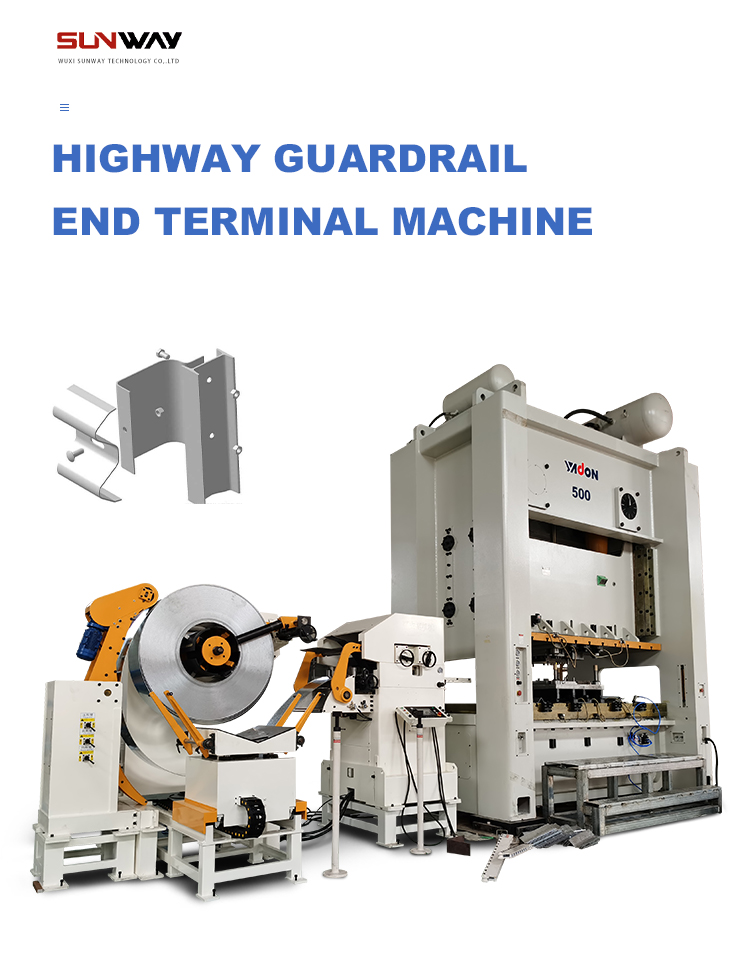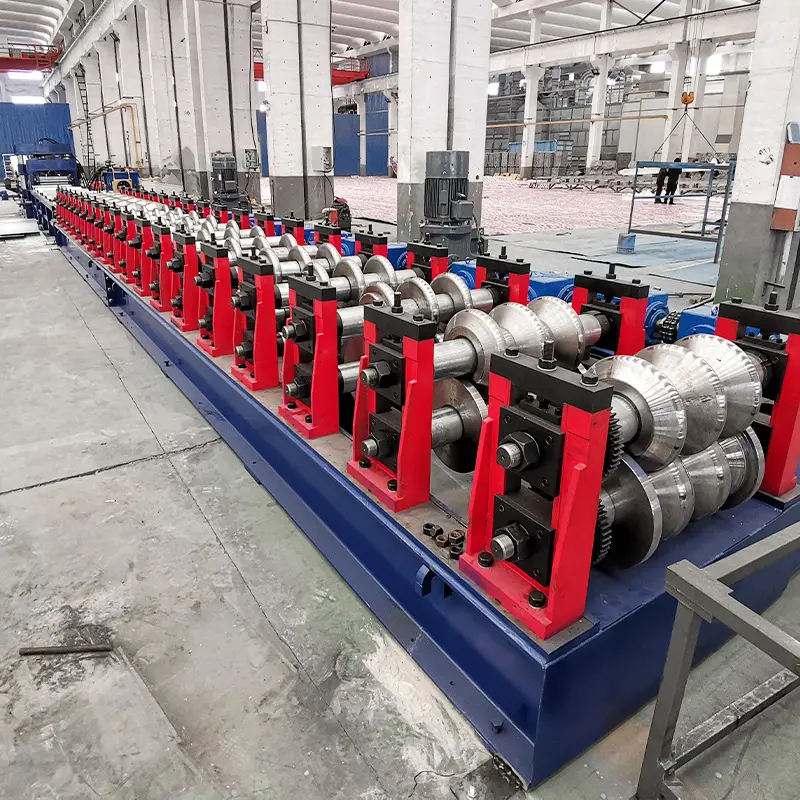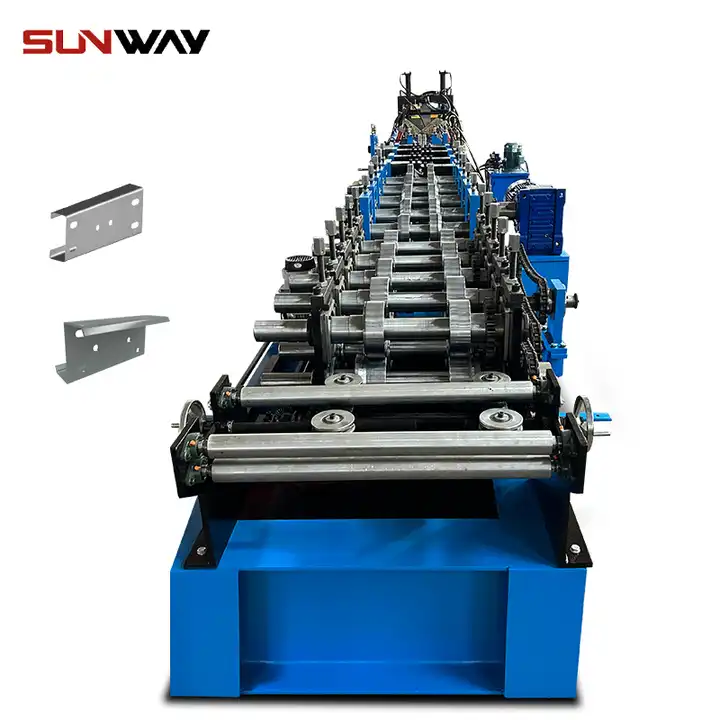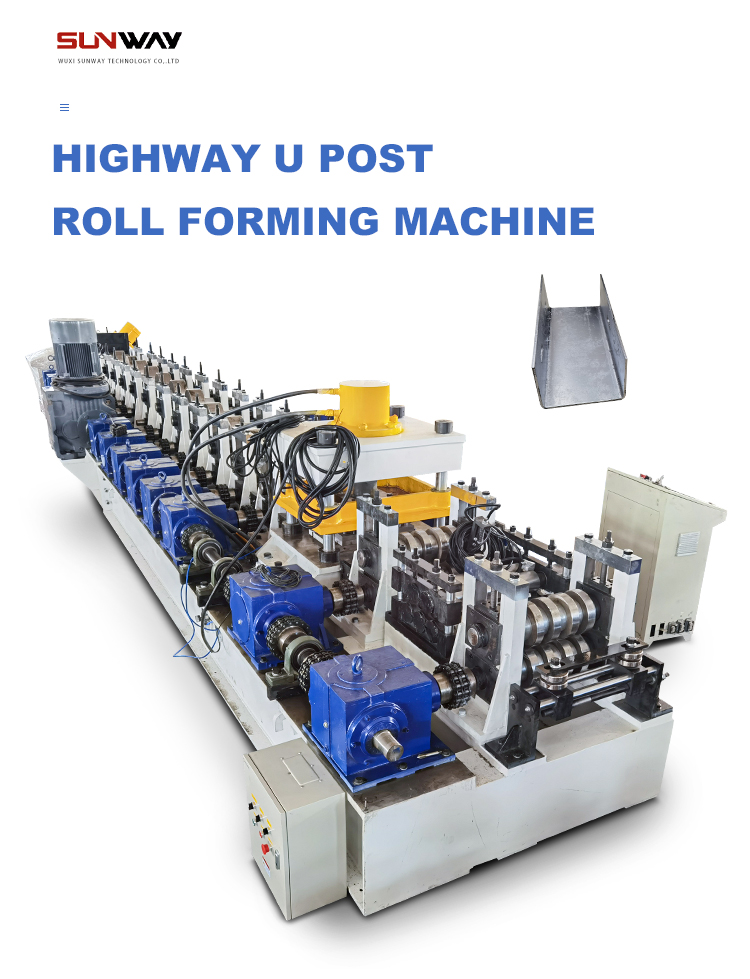التشكيل بالدلفنة على الجنزير هو عملية تشكيل المعادن تُستخدم لتشكيل الصفائح المعدنية في مقاطع جانبية مخصصة ذات مقاطع عرضية متكررة. ماكينات التشكيل بالدلفنة على الجنزير مصممة للإنتاج المستمر الفعال للقطع المعدنية بجودة ثابتة.
يوفر هذا الدليل الشامل معلومات أساسية عن معدات تشكيل لفة الجنزير لمساعدتك على فهم طريقة عملها، وتطبيقاتها، وتفاصيل المواصفات، وخيارات الموردين وغير ذلك الكثير.
نظرة عامة على ماكينات تشكيل الجنزير
تقوم ماكينات التشكيل بالدلفنة على الجنزير بتشكيل اللفائف المعدنية إلى أجزاء مخصصة عن طريق ثني الشريط تدريجيًا من خلال مجموعات متتالية من اللفائف. تقوم كل مجموعة بكرات بإجراء ثني تدريجي حتى يتم الحصول على شكل المقطع العرضي المطلوب.
الملامح الرئيسية لخطوط تشكيل لفة الجنزير
- الإنتاج المستمر للملامح ذات المقاطع العرضية المتكررة
- إنتاجية عالية وسرعات تصل إلى 100 م/دقيقة
- القدرة على تشكيل أشكال معقدة وغير متماثلة
- تفاوتات صارمة واتساق ممتاز في جودة المنتج
- انخفاض تكاليف الأدوات مقارنة بالعمليات الأخرى
- الحد الأدنى من نفايات المواد ومتطلبات مساحة أصغر
- التشغيل الآلي للكفاءة والدقة العالية
- المرونة في تبديل الملفات الشخصية بسرعة
المكونات الرئيسية لنظام التشكيل بالدلفنة على الجنزير
تشمل المكونات الرئيسية لخط تشكيل لفة الجنزير ما يلي:
| المكوّن | الوظيفة |
|---|---|
| Uncoiler | يحمل لفائف الصفيحة المعدنية المراد تشكيلها |
| مجموعة التغذية | تغذية الشريط المعدني في قسم التشكيل بسرعة ثابتة |
| محطات التشكيل بالدلفنة | مجموعات متدرجة من البكرات التي تؤدي انحناءات متزايدة |
| تحكم PLC | تحكم دقيق في كل محطة وخط عام |
| جهاز القطع | تقطيع التشكيلات النهائية إلى الأطوال المطلوبة |
| جدول النفاد | يدعم التشكيلات الجانبية المشكلة التي تغادر المحطة الأخيرة |
أنواع ماكينات تشكيل الجنزير
تتوفر أنظمة التشكيل بالدلفنة على الجنزير في تكوينات مختلفة مصممة لتطبيقات محددة:
- قياسي - اللفافة الأساسية للأجزاء الطويلة مثل الألواح والقضبان والقضبان والمسارات
- على شكل حرف C - لتشكيل مقاطع القنوات المغلقة والإطارات المغلقة
- على شكل حرف O - للملامح الشبيهة بالأنابيب المجوفة ذات المقطع المفتوح
- التخصص - ماكينات مخصصة للأشكال المعقدة مثل المربعات والقطع الناقص
مبدأ عمل خطوط تشكيل لفة الجنزير
ينطوي مبدأ العمل على:
- يتم تغذية لفائف الصفائح المعدنية المحملة على آلة فك اللفائف في قسم التشكيل بالدلفنة
- تطبق محطات الأسطوانة التدريجية الانحناءات التدريجية لتشكيل المظهر الجانبي تدريجياً
- بكرات يتم التحكم فيها عن طريق التحكم المنطقي القابل للبرمجة القابلة للبرمجة (PLC) لتشكيل الشريط بدقة دون عيوب
- جهاز القطع يقطع الأجزاء النهائية بالطول المطلوب
- خروج التشكيلات الجانبية المشكلة على طاولة الجري للتجميع

تطبيقات ماكينات تشكيل الجنزير
يستخدم التشكيل بالدلفنة على الجنزير لإنتاج أجزاء معدنية طويلة ومستقيمة ذات مقاطع عرضية ثابتة في العديد من الصناعات:
الإنشاءات والبنية التحتية
- الأسقف المعدنية
- ألواح الحائط
- قضبان حراسة الطرق السريعة
- دعامات السقف الفولاذية
- أسطح الجسور
- الممرات
- الإطارات الهيكلية
النقل والمواصلات
- قضبان السكك الحديدية
- إطارات الشاحنات
- ألواح هيكل الحافلة
- الحوائط الجانبية لعربات السكك الحديدية
- هياكل السفن والمنصات
الأثاث
- إطارات السرير
- معايير الرفوف
- دعامات رف التخزين
- بطانات الثلاجة
- إطارات أثاث مكتبي
السيارات
- أجزاء الشاسيه
- المصدات والأقواس
- عوارض الباب
- إطارات المقاعد
- مكونات العادم
الأجهزة المنزلية
- براميل الغسالة
- ألواح الثلاجة
- شبكات مكيف الهواء
- العبوات الكهربائية
- معدات المطبخ
مقارنة الأجزاء المشكلة بالدرفلة مقابل الطرق الأخرى
| المعلمة | ملفوف على شكل لفة | مختوم | مقذوف |
|---|---|---|---|
| تعقيد الشكل | متوسط | عالية | منخفضة |
| القوة | متوسط | عالية | متوسط |
| دقة الأبعاد | عالية | متوسط | عالية |
| تشطيب السطح | جيد | ممتاز | جيد |
| وقت الإعداد | منخفضة | عالية | متوسط |
| تكلفة الأدوات | منخفضة | عالية جداً | عالية |
| معدل الإنتاج | عالية | متوسط | متوسط |
| طول الجزء | مستمر | محدودة | مستمر |
| كفاءة التكلفة | عالية | منخفضة | متوسط |
كيفية اختيار ماكينة تشكيل لفة الجنزير
يتطلب اختيار خط التشكيل بالدلفنة المناسب للمسار الصحيح مطابقة قدرات المعدات مع متطلبات المنتج:
شكل المنتج وأبعاده
- السعة لحجم الجزء، والعرض، والسماكة، والطول
- أشكال هندسية ممكنة - مفتوحة، مغلقة، مستديرة، إلخ.
- التفاوتات المطلوبة
احتياجات مخرجات الإنتاج
- سرعة الإخراج المطلوبة بالقدم/الدقيقة
- عرض الملف وسماكته وخامته
- الحجم السنوي الذي سيتم إنتاجه
تكوين الخط
- عدد محطات الرول المطلوبة
- نوع وحدة التفكيك، والمغذي، والقطع
- مستوى الأتمتة
- تخطيط الخط - النوع C، النوع O، النوع القياسي، إلخ.
معايير الجودة
- مستوى تشطيب السطح المطلوب
- التفاوتات المطلوب تحقيقها
- القدرة على ميزات القِطع مثل الثقوب والنقش
قيود الميزانية
- الاستثمار الرأسمالي للمعدات
- تكاليف التشغيل - العمالة والمرافق والصيانة
- فترة الاسترداد المتوقعة
تضمن مطابقة طراز وخصائص اللفافة القابلة للطي مع مواصفات المنتج الحصول على أفضل النتائج.

مواصفات ماكينات تشكيل الجنزير
المواصفات والمعايير الرئيسية التي يجب أخذها في الاعتبار بالنسبة لقوالب بكرات الجنزير هي:
أبعاد المعدات
- الطول والعرض والارتفاع
- نمط تخطيط الخط - نوع C أو O أو I
- عدد محطات التشكيل بالدلفنة
- المساحة المطلوبة للتشغيل والصيانة
القيادة والسرعة
- سرعة التشكيل بالقدم في الدقيقة
- قوة المحرك وعزم الدوران
- نوع نظام التحكم في السرعة
رولز
- قطر الأسطوانة وعرضها
- مواد اللفائف - الصلب والفولاذ الكربوني وسبائك الصلب
- مستوى صلابة البكرة
- لفات تغيير سريعة لتغيير الملامح
القدرات المادية
- نطاق عرض الملفات المستوعبة
- نطاق السماكة الممكنة
- أنواع المواد - الصلب، الفولاذ، الفولاذ المقاوم للصدأ، الألومنيوم، إلخ.
- قوة الشد القصوى للشريط
الأدوات
- أدوات التغيير السريع للتبديل السريع للملف الشخصي
- أدوات للمميزات الخاصة مثل الوخز والتثقيب والنقش
الأتمتة
- محركات المحركات المؤازرة للدقة
- PLC و HMI للتحكم
- أجهزة استشعار لمراقبة التشغيل
- أنظمة التشحيم الأوتوماتيكية
معدات المناولة
- سعة حمل اللفائف لفك اللفائف
- نوع المغذيات - بكرة قرص، محمل كروي للمغزل
- جهاز القطع - القص الطائر، والقص الدوار وما إلى ذلك.
- طول طاولة التشغيل والناقلات
تؤثر المواصفات تأثيرًا مباشرًا على جودة القِطع المشكّلة بالدلفنة ومعدلات الإنتاج وتكاليف الخط.
معايير التصميم والهندسة
يجب تصميم ماكينات التشكيل بالدلفنة على الجنزير وتصنيعها واختبارها وفقًا للمعايير ذات الصلة لتحقيق الأداء الأمثل.
رموز التصميم الإنشائي
- مواصفات AISC للإنشاءات الفولاذية
- معايير ASME للحراسة والسلامة ASME
- IBC لأحمال الرياح والزلازل والمباني
- معايير MBMA لأنظمة المباني المعدنية
المعايير المادية
- معايير ASTM للمعادن مثل ASTM A1008، A653، A792
- معايير EN، DIN للمواد الأوروبية
إرشادات العملية
- إرشادات AISI لإطارات الصلب المشكل على البارد
- معايير AWS للحام
- توصيات SAE للمثبتات
معايير نظام التحكم
- معايير UL و CSA و CE للأنظمة الكهربائية
- ISO 13849 للضوابط المتعلقة بالسلامة
- IEC 61131 لبرمجة PLC
الاختبار والفحص
- معايير ASTM لاختبار المواد
- أكواد AWS لفحص اللحام
- شهادة FEMA الزلزالية
- شهادة لوحة UL
يضمن اتباع الرموز ذات الصلة أن تفي اللفافة السابقة لللفافة بمتطلبات الجودة والسلامة والأداء.
مصنعي وموردي ماكينات التشكيل بالدرفلة
بعض الموردين العالميين الرائدين في مجال معدات تشكيل لفة الجنزير هم:
ميتفورم إنترناشيونال
- تقديم خطوط تشكيل كاملة للملامح القياسية والمخصصة
- قدرات الفولاذ عالي القوة والأجزاء الكبيرة
- مرافق التصنيع في الولايات المتحدة الأمريكية وتايلاند والصين
مجموعة Formtek
- مجموعة واسعة من أدوات تشكيل البكرات القياسية والمتخصصة
- سرعة تشكيل قصوى تبلغ 130 م/دقيقة
- تصميم وإنتاج الملف الشخصي المخصص
ماكينات التشكيل بالدرفلة في هانغتشو
- التركيز على خطوط التشكيل بالدلفنة لصناعة البناء والتشييد
- أنظمة التحكم المنطقي القابل للبرمجة القابلة للبرمجة (PLC) المتقدمة
- معدات التشكيل بالدرفلة المصدرة إلى جميع أنحاء العالم
أنهوي يومينغ لتكنولوجيا ماكينات أنهوي
- القوالب الدوارة للأسقف والأرفف والأثاث وصناعة السيارات
- خطوط إنتاج يتم التحكم فيها باستخدام الحاسب الآلي الرقمي
- مركز البحث والتطوير لتطوير المنتجات الجديدة
Moderne Technologie d'Usinage S.A.
- 50 عامًا من الخبرة في التشكيل بالدرفلة الدقيقة
- ماكينات التشكيل بالدلفنة المخصصة والقياسية
- مشاريع جاهزة للتسليم على مستوى العالم
وبالإضافة إلى ذلك، يقدم العديد من المصنعين الإقليميين ومصنعي المعدات الأصلية خيارات معدات التشكيل بالدرفلة التي تلبي احتياجات الأسواق المحلية.
تسعير الرول السابق
تعتمد التكلفة السابقة للفة على عوامل مثل:
- حجم الخط وسرعة الإنتاج
- عدد المحطات الدوارة
- مستوى الأتمتة والضوابط
- القدرات المادية
- تكوين الخط - النوع C أو O أو I
- المعدات الإضافية مثل آلات فك اللفائف، وطاولات الجريان وما إلى ذلك.
نطاق التسعير الإرشادي
- القوالب الدوارة الصغيرة - $50,000 إلى $100,000
- الخطوط المتوسطة - $150,000 إلى $500,000
- الأنظمة ذات السعة العالية - $600,000 إلى $2 مليون
- ماكينات تشكيل البكرات المخصصة - $500,000 إلى $5 مليون
يساعد البحث عن عروض تنافسية من الموردين المختارين على إيجاد القيمة المثلى.

كيفية اختيار الشركة المصنعة لماكينة تشكيل الجنزير
يتضمن اختيار المصنّع الأصلي المناسب لفافة البكرات المناسبة:
جودة المنتج
- استخدام الآلات الدقيقة والمكونات الموثوقة
- مراقبة الجودة والاختبارات الصارمة
- الامتثال للمعايير - ISO 9001، CE
- جودة القِطع المشكّلة الملفوفة المتناسقة
الخبرة الفنية
- خبرة في التصميم والبناء السابق للفة السابقة
- الهندسة الداخلية للملامح الشخصية
- معرفة أحدث المعايير والعمليات
- قدرات التركيب والدعم الميداني
إمكانية التخصيص
- تقديم ماكينات مخصصة لملامح خاصة
- المرونة في تخطيط الخط وميزاته
- تكامل العمليات الثانوية مثل التثقيب واللحام
- حلول التحكم والأتمتة المخصصة
الاستجابة والدعم
- الاستجابة السريعة لطلبات تقديم العروض والاستفسارات
- مهل زمنية أقصر للتسليم
- قطع غيار وخدمة متوفرة بسهولة
- المساعدة في استكشاف الأخطاء وإصلاحها عبر الاتصال عن بُعد
التسعير
- القدرة التنافسية من حيث التكلفة
- تسعير عادل للإمكانيات
- قيمة جيدة مقابل المال
- خيارات دفع مرنة
يؤدي اختيار الشركة المصنعة ذات الخبرة ذات الصلة إلى الحصول على نظام تشكيل بالدلفنة عالي الأداء.
تركيب وتشغيل ماكينات تشكيل لفة الجنزير
تُعد إجراءات التركيب والتشغيل السليمة أمرًا حيويًا لتشغيل بكرات الجنزير بدون مشاكل.
التركيب
- تم الانتهاء من الأعمال المدنية لتركيب الخط
- تفريغ المعدات باستخدام الرافعات والرافعات الشوكية
- تموضع مكونات الخط ومحاذاة الخطوط
- تجميع المحطات وفقًا للرسومات
- تسوية الماكينات وتثبيتها على الأساسات
- توصيلات الطاقة والمرافق والهواء المضغوط
- التشغيل التجريبي والاختبار قبل الإنتاج
العملية
- تعديلات الأسطوانة لإعدادات الملف الشخصي
- أدلة الدخول بمحاذاة عرض الملف
- عمليات التشغيل التجريبية للتحقق من تدفق الشريط والملف الشخصي المشكل
- مراقبة سرعة الخط والمحركات والطاقة
- نظام تغذية لضمان تغذية ثابتة للمواد
- مستشعرات لاكتشاف الاختناقات أو الأعطال
- تشحيم الأجزاء المتحركة
- صيانة النظام الهيدروليكي
- تغيير الأدوات حسب الجدول الزمني للإنتاج
إن اتباع ممارسات موحدة للتركيب والتشغيل يعزز الإنتاجية.
صيانة معدات تشكيل لفة الجنزير
الصيانة الوقائية هي المفتاح لاستمرار عمل القوالب الدوارة.
الصيانة المجدولة
- الفحوصات اليومية لمحاذاة البكرة، وتوجيه الشريط
- فحص المحركات والمحامل وعلب التروس
- مراقبة مستويات الزيت في المكونات الهيدروليكية
- تنظيف خزانات PLC، ومرشحات الهواء
- ملاحظة تآكل اللفافة والشريط
- فحص الأنظمة الكهربائية والهيدروليكية
- شد السحابة، وتشحيم التروس
- تغيير الزيت، والتشحيم كما هو محدد
الصيانة الشاملة
- إعادة طحن البكرات أو التسطيح الصلب
- إصلاح علبة التروس أو استبدالها
- استبدال المكونات البالية أو التالفة
- تنظيف النظام الهيدروليكي وتغيير السوائل
- تجديد أجهزة PLC
- ترقية أو إعادة برمجة عناصر التحكم
- معايرة الأدوات وأجهزة الاستشعار
صيانة الأعطال
- استكشاف الأعطال والأعطال وإصلاحها
- إصلاح البكرات، أو الأدوات، أو أنظمة التغذية
- إصلاح مشكلات الناقل والتشويش
- الإصلاحات الكهربائية وإعادة التمديدات الكهربائية
- الاستبدال الطارئ للمكونات التالفة
- التشغيل التجريبي والتشغيل التجريبي قبل استئناف الإنتاج
تقلل الصيانة الاستباقية من وقت التوقف عن العمل وتزيد من وقت التشغيل السابق.
مزايا وقيود تشكيل لفات الجنزير
المزايا
- معدلات إنتاج عالية تصل إلى 100 متر/دقيقة
- التشكيل المستمر للمقاطع الجانبية التي يصل طولها إلى 50 قدمًا
- جودة الملف الشخصي المتسقة والقابلة للتكرار
- تفاوتات ضيقة تصل إلى +/- 0.5 مم
- مرونة الأدوات تسمح بتغيير المظهر الجانبي
- تكلفة استثمار أقل مقارنة بالعمليات الأخرى
- وفورات في المواد من القليل من النفايات
- بصمة أصغر من طرق تشكيل المعادن الأخرى
القيود
- غير مناسب للقطع القصيرة والصغيرة
- قيود الحجم من عرض الملف وسماكته
- تعقيد الملف الشخصي المحدود مقابل العمليات الأخرى
- يلزم إجراء تجارب أدوات أعلى للملامح المخصصة
- عمليات ثانوية غالباً ما تكون مطلوبة للفتحات والشقوق وما إلى ذلك.
- قوة الشريط الكبيرة والدقة المطلوبة
- تدابير خاصة للمواد عالية القوة
يساعد فهم كل من الإيجابيات والسلبيات على تحديد التطبيقات المثلى.
كيف يقارن التشكيل بالدلفنة على الجنزير بطرق تشكيل المعادن الأخرى
مقابل ثني المكابح بالضغط على المكابح
- مكابح الضغط تقتصر على الأجزاء الأقصر
- أطنان أقل للتشكيل بالدلفنة
- لا توجد قيود على الطول مع التشكيل بالدلفنة
- ارتفاع تكلفة الأدوات الأولية لمكابح الضغط
- تبديل أسرع على القوالب الدوارة
- تحتاج مكابح المكابس إلى إعداد ماهرة
مقابل بثق الفولاذ
- تشطيب أفضل للسطح مع التشكيل بالدلفنة
- أدوات أبسط تسمح بتغيير التشكيل الجانبي بسرعة
- المزيد من قيود الحجم مع البثق
- تكلفة أقل لأدوات التشكيل بالدلفنة المخصصة
- يحتاج البثق إلى أحجام كبيرة لتبرير التكلفة
- خصائص الصلب المشكل بالدرفلة أكثر اتساقًا
مقابل ختم المعادن
- الختم التدريجي عملية مستمرة أيضًا
- طريقة التشكيل بالدلفنة بطريقة أبسط للقطع الطويلة
- لا توجد مشاكل تجريد مع التشكيل بالدلفنة
- انخفاض تكاليف أدوات تشكيل البكرات القابلة للطي
- يحتاج الختم إلى دقة أكبر في الضرب
- لا يزال التصنيع الثانوي مطلوبًا في كثير من الأحيان
تساعد المفاضلة بين المفاضلات في اختيار العملية المثلى.

التعليمات
ما هي أنواع المواد التي يمكنك دحرجتها؟
التشكيل بالدلفنة مناسب لمعظم الصفائح المعدنية بما في ذلك الفولاذ الطري والفولاذ المقاوم للصدأ والألومنيوم والنحاس والنحاس الأصفر والنحاس الأصفر حتى سمك 6 مم. وباستخدام أدوات خاصة، يمكن لبعض الماكينات تشكيل الفولاذ عالي القوة الذي يزيد عن 1250 ميجا باسكال.
كيف تقوم بتصميم ملف جانبي ملفوف؟
يتضمن تصميم المظهر الجانبي للتشكيل بالدلفنة نمذجة التصميم بمساعدة الحاسوب، وتحديد تسلسلات الانحناء، وتوصيات المواد، وتحليل FEA، وتصميم الأدوات، وتجارب التشكيل بالدلفنة التكرارية لتطوير المظهر الجانبي الأمثل.
ما الذي يحدد سرعة التشكيل بالدلفنة؟
تعتمد السرعة القصوى للإنتاج على عوامل مثل سُمك المادة وطول الخط وتعقيد التشكيل وعدد محطات التشكيل وقوة المحرك وقدرة السرعة المصممة للماكينة.
ما مدى دقة التشكيل بالدلفنة؟
من خلال التكوين المناسب للماكينة، والأدوات الدقيقة، والتحكم في تغذية الشريط، يمكن أن تحقق الأجزاء المشكلة بالدلفنة تفاوتات تفاوتات في الأبعاد تبلغ +/- 0.5 مم (+/- 0.02″)
ما هي تكلفة ماكينة التشكيل بالدلفنة؟
تتباين تكلفة البكرات على نطاق واسع من $50,000 للماكينات الأساسية إلى $5 مليون دولار للخطوط الكبيرة المخصصة. العوامل الرئيسية التي تحدد السعر هي سرعة الإنتاج والحجم ومستوى الأتمتة واحتياجات التخصيص.
كم من الوقت تدوم ماكينة التشكيل بالدرفلة؟
مع التشغيل السليم والصيانة الوقائية، عادةً ما يكون عمر ماكينة تشكيل اللفائف من 15 إلى 20 عامًا. ويمكن للتحديثات الدورية لأجهزة التحكم، والمكونات الهيدروليكية، والأدوات وما إلى ذلك أن تزيد من عمر المعدات.
هل يمكنك لحام مقطع مُشكّل بالدلفنة؟
نعم، يمكن إجراء تصنيع إضافي مثل اللحام على الأجزاء المشكلة بالدرفلة إما عن طريق دمج عمليات ثانوية على الخط أو في عمليات منفصلة.
كيف تحافظ على أدوات التشكيل بالدلفنة؟
تشمل مهام الصيانة الشائعة التشحيم المجدول، والتنظيف اليومي، والفحص البصري للتآكل أو التلف، وإعادة الطحن أو التسطيح الصلب للبكرات حسب الحاجة، واستبدال المكونات التالفة.
لماذا يُعد التشكيل بالدرفلة أفضل من العمليات الأخرى؟
تشمل مزايا التشكيل بالدرفلة السرعات العالية، وعمليات الإنتاج المستمرة، والتفاوتات المتقاربة، وتغييرات التشكيل المرنة، وانخفاض تكلفة الأجزاء الطويلة، وتقليل نفايات المواد مقارنةً بطرق تشكيل المعادن الأخرى.
ما هي السلامة المطلوبة للتشكيل بالدلفنة؟
عناصر السلامة الحرجة هي الحراسة المناسبة للماكينات، والتوقف في حالات الطوارئ، وإيقاف التشغيل في حالات الطوارئ، وإغلاق الصيانة، وأنظمة السلامة الكهربائية، وحراس الناقل، وحماية السمع، ومعدات الحماية لمناولة مخزون اللفائف والأجزاء المشكلة.
استنتاج
التشكيل بالدلفنة عملية فعالة للإنتاج المستمر للمقاطع المعدنية الدقيقة في العديد من الصناعات. توفر خطوط التشكيل بالدلفنة على الجنزير مع محطات تشكيل متعددة إنتاجية عالية للأجزاء الطويلة مثل الألواح والقضبان ومكونات الأسقف.
إن اختيار ماكينة التشكيل المناسبة بناءً على احتياجات المنتج، وتحسين تصميم الخط، والتشغيل والصيانة المناسبين يمكّن التشكيل بالدلفنة من إنتاج القطع المعدنية بدقة وسرعة ومرونة.
وبفضل مزاياها المتمثلة في سرعة الإعداد والتكلفة المنخفضة والمتطلبات البسيطة، من المتوقع أن تشهد ماكينات تشكيل بكرات الجنزير نموًا مستمرًا في السنوات القادمة في مختلف القطاعات.


